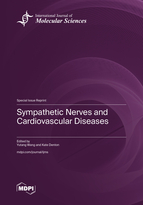Sympathetic Nerves and Cardiovascular Diseases
A special issue of International Journal of Molecular Sciences (ISSN 1422-0067). This special issue belongs to the section "Molecular Pathology, Diagnostics, and Therapeutics".
Deadline for manuscript submissions: closed (30 November 2022) | Viewed by 31491
Special Issue Editors
Interests: cardiovascular disease; hypertension; diabetes; atherosclerosis; abdominal aortic aneurysm; renal denervation; dyslipidemia; hyperuricemia
Special Issues, Collections and Topics in MDPI journals
Interests: cardiovascular disease; kidney disease; renin-angiotensin system; renal sympathetic nerves; hypertension; pregnancy
Special Issues, Collections and Topics in MDPI journals
Special Issue Information
Dear Colleagues,
Cardiovascular diseases (CVDs) are a group of disorders of the heart and blood vessels, including heart attack and stroke. According to the World Health Organization, cardiovascular diseases (CVDs) are the leading causes of death globally. An estimated 17.9 million people died from CVDs in 2019, representing 32% of all global deaths. The common risk factors for CVDs include hypertension, diabetes, dyslipidemia, and obesity among others. It has been shown that sympathetic nerve activity is often increased under these conditions, and the inhibition of sympathetic nerve activity (e.g., via renal denervation) has been shown to decrease blood pressure and improve glycaemic control. This Special Issue of IJMS will cover the latest developments in the effect of sympathetic nerve activity on CVDs. It will explore the molecular mechanisms underlying the contribution of sympathetic nerve activity to the development of CVDs. Articles focusing on the effect of sympathetic nerve activity on heart failure, arrhythmia, stroke, atherosclerosis, hypertension, diabetes, dyslipidemia, obesity, and renal disease are of particular interest.
Dr. Yutang Wang
Prof. Dr. Kate Denton
Guest Editors
Manuscript Submission Information
Manuscripts should be submitted online at www.mdpi.com by registering and logging in to this website. Once you are registered, click here to go to the submission form. Manuscripts can be submitted until the deadline. All submissions that pass pre-check are peer-reviewed. Accepted papers will be published continuously in the journal (as soon as accepted) and will be listed together on the special issue website. Research articles, review articles as well as short communications are invited. For planned papers, a title and short abstract (about 100 words) can be sent to the Editorial Office for announcement on this website.
Submitted manuscripts should not have been published previously, nor be under consideration for publication elsewhere (except conference proceedings papers). All manuscripts are thoroughly refereed through a single-blind peer-review process. A guide for authors and other relevant information for submission of manuscripts is available on the Instructions for Authors page. International Journal of Molecular Sciences is an international peer-reviewed open access semimonthly journal published by MDPI.
Please visit the Instructions for Authors page before submitting a manuscript. There is an Article Processing Charge (APC) for publication in this open access journal. For details about the APC please see here. Submitted papers should be well formatted and use good English. Authors may use MDPI's English editing service prior to publication or during author revisions.
Keywords
- sympathetic nerve activity
- renal denervation
- heart disease
- stroke
- atherosclerosis
- hypertension
- vascular remodeling
- diabetes
- metabolic syndrome
- kidney disease








